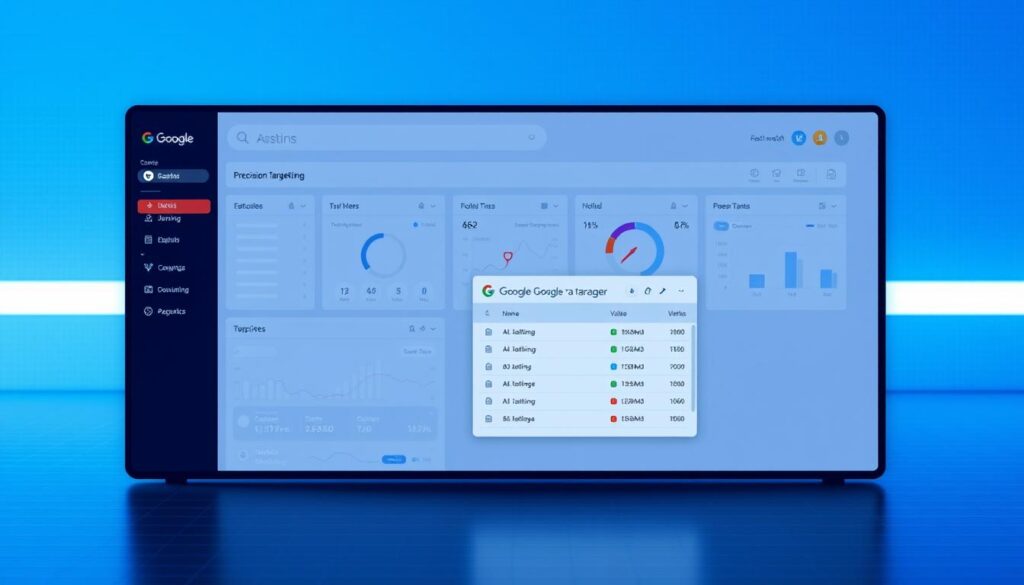Today, being good at automated GTM targeting is a must for marketers wanting to make their campaigns better. Google Tag Manager automation makes it easy for marketers to use and control tags without having to know a lot about coding. This makes the work that used to take a lot of effort much simpler. We’ll dive into the details of automated GTM targeting and show how automation makes marketing better.
We’ll give you tips on setting up your Google Tag Manager to succeed and go over GTM strategies aimed at targeting. You’ll get helpful advice to greatly improve how you manage campaigns. Get ready to learn how GTM optimization can change your marketing for the better.
Key Takeaways
- Understanding the significance of automated GTM targeting in modern marketing.
- Importance of integrating Google Tag Manager automation with existing marketing tools.
- Effective audience segmentation techniques for maximizing campaign impact.
- Strategies for optimizing campaign performance through data analysis and A/B testing.
- Navigating compliance with data regulations like GDPR and CCPA.
- Future trends in automated GTM targeting and the role of emerging technologies.
Understanding Automated GTM Targeting
Automated GTM targeting marks a big step forward in marketing. It uses Google Tag Manager (GTM) to make managing marketing tags easier and improve tracking. Marketers can put tracking codes in place quickly without always needing IT help. This lets them react fast to changes in the market.
Definition of Automated GTM Targeting
Automated GTM targeting means using GTM smartly to track how people interact with brands and handle tags. Marketers can easily update information, keeping up with user habits while collecting data in an organized way.
Benefits of Automation in Marketing
Automation in marketing offers a lot of benefits. It makes teams more efficient, freeing them up to work on bigger ideas instead of coding over and over. Better analytics offer deeper insights for smarter business choices. Marketers save money as automation cuts down manual work, making budget planning easier.
Key Components of GTM Targeting
Knowing the main parts of GTM targeting is key for good results. The three big pieces are:
- Tags: Small bits of code that gather and send data.
- Triggers: Rules that decide when tags collect certain actions.
- Variables: Details that give context and help tags work right.
Getting good with these parts improves analysis skills, understanding of the audience, and how well marketing works.
To dive deeper, explore how combining automated GTM targeting with grouping audiences can boost your campaigns. Check out effective marketing automation practices for better campaign results and more engagement.
Setting Up for Success
To use automated tag management well, integrating GTM with your marketing tools is key. Connecting with platforms like Google Analytics and CRM systems makes data flow better. This link boosts your campaign’s insights. A good integration lets GTM automation work better, making sure data is useful and up-to-date.
Integrating Automated GTM with Your Marketing Tools
Linking GTM with your marketing tools can improve your results. By connecting automated tag management with key systems, you get a full picture of how users interact. This broad view helps gather important data from many places, making marketing more effective.
Ensuring Data Accuracy and Relevance
To keep marketing data right, firms need good data collection methods. Not checking often can create errors that mess up your data. By regularly testing and fixing tags, you make sure your data stays correct and useful. Marketers should focus on these tasks to avoid mistakes that could lead to wrong conclusions and block smart decision-making.
Choosing the Right Triggers
Finding the right triggers is key for the best results in automated targeting with GTM. It’s all about knowing the different trigger types to meet your goals. Knowing how each type works makes collecting and analyzing data better.
Types of Triggers in GTM
Google Tag Manager (GTM) has many triggers for tracking user actions. Here are some common ones:
- Click Triggers: These track clicks on things like links, buttons, and phone numbers.
- Page View Triggers: Great for tracking when specific pages or sections are viewed.
- Form Submission Triggers: These follow form submissions, even without a page change.
- Scroll Depth Triggers: These measure how much of a page users scroll through.
Every trigger is important for getting better data through GTM. This helps in making smarter marketing moves.
Best Practices for Selecting Triggers
To make your GTM work well, picking the right triggers carefully is crucial. Match your triggers with your marketing goals. Testing them well before use is also important. Clear names for triggers help everyone understand and work together better.
Learn how to pick the best triggers, check out this detailed guide on GTM triggers
Following these tips can really boost your automated marketing, leading to great outcomes.
Segmenting Your Audience Effectively
Segmenting your audience right is key to great marketing. It means figuring out who your audience is, in smaller groups. Then, you can make messages just for them. This makes people more interested, helps sell more, and gets better results from marketing. Knowing how to segment well helps marketers do their job even better.
Importance of Audience Segmentation
Audience segmentation is super important. It lets marketers tailor experiences, making customers more loyal. By focusing on the right groups, businesses save resources and make customers happier. If a message hits home, people are more likely to buy and tell others about the brand.
Techniques for Precise Segmentation
To segment an audience well, you need to mix different kinds of data. Use age, gender, and where people live for demographic data. Add what interests them and their values for psychographic insights. Then, see how they behave and respond to your marketing. This makes your messages super targeted, reaching those most likely to be interested.
| Segmentation Type | Description | Examples |
|---|---|---|
| Demographic | Segments based on statistical characteristics | Age, Gender, Income |
| Psychographic | Segments based on psychological attributes | Interests, Values, Lifestyle |
| Behavioral | Segments based on consumer behavior and usage | Purchase history, User engagement, Brand loyalty |

Optimizing Campaign Performance
For marketers aiming high, optimizing campaign performance is key. They need to examine various metrics to better their strategies. This involves looking at conversion rates, bounce rates, and user engagement. These numbers give insights into how well campaigns reach their intended audiences.
Analyzing Metrics to Improve Targeting
Using automated GTM tools helps in making data-driven choices. It’s important for marketers to check key indicators. This shows what’s working and what’s not. Knowing what clicks with your audience can make your GTM optimization sharper and your targeting strategies more accurate.
A/B Testing for Enhanced Results
A/B testing is vital for fine-tuning campaigns. It involves testing different ad versions or landing pages. This helps in identifying what works best. With this method, businesses can keep improving their marketing efforts. They ensure they meet the evolving tastes and preferences of their audience.
Evaluating Return on Investment (ROI)
Evaluating ROI is essential to understand a campaign’s financial effectiveness. Keeping an eye on ROI lets companies see if they’re using resources wisely. Making sure campaigns are cost-effective and successful is crucial. This focus on ROI ensures strategies lead to the outcomes businesses aim for.
Leveraging Custom Variables
Custom variables in Google Tag Manager (GTM) are crucial for marketers. They help get deeper insights beyond the usual metrics. This is key for making your marketing efforts fit specific user actions.
What Are Custom Variables?
Custom variables let marketers capture unique details of how users interact with their sites. They gather data that regular metrics might miss. Here are some examples of custom variables:
- URL Variables: Extract specific parts of a URL for tracking.
- DOM Element Variables: Capture the value of specific HTML elements.
- First-party Cookie Variables: Retrieve cookie values set by the website.
- JavaScript Variables: Execute custom JavaScript code within GTM.
- DataLayer Variables: Access values from the GTM Data Layer.
Utilizing Custom Variables for Targeting
Using custom variables is key for better targeting with gtm. They let marketers track detailed actions, like button clicks or form fills. This leads to insights that help tweak campaigns. Custom variables also help track unique traits in Google Analytics 4. For more detailed ways to use these tools, check out this resource.

Staying Compliant with Data Regulations
In the digital marketing world, keeping up with data rules is a must. This helps build trust with customers and keeps you out of legal trouble. Marketers need to really get GDPR and CCPA. Knowing these regulations lets them handle data right and respect user privacy.
Understanding GDPR and CCPA
The GDPR is a tough privacy law from the European Union. It sets rules on how to gather and use data. The CCPA does something similar for folks in California, letting them control their own information. Both laws stress being open, getting permission, and letting people see or remove their data. If you use automated GTM, you must know these rules well to keep trust with your audience.
Best Practices for Compliance in Automated GTM
To follow the law in automated GTM, there are some key steps to take:
- Getting clear okay from users before tracking their data.
- Telling them how their info will be used in simple terms.
- Keeping privacy policies up to date and easy to understand.
- Keeping track of how data is used to show you’re responsible.
- Teaching your marketing team about new data laws regularly.
Using these methods helps reduce risks and makes your marketing more trustworthy. As rules change, staying up-to-date and adjusting is key to doing well.
| Regulation | Key Focus | Consumer Rights |
|---|---|---|
| GDPR | Data protection, privacy rights | Right to access, erasure, rectification |
| CCPA | Consumer data protection in California | Right to know, deletion, opt-out of sales |
Future Trends in Automated GTM Targeting
Marketing is changing fast, with automated GTM targeting leading the change. Marketing automation technologies are improving data analysis. This helps marketers understand their audiences better by using real-time insights. With this tech, companies can target better and make their work flow smoother.
Emerging Technologies in Marketing Automation
Artificial intelligence and machine learning are big in marketing automation today. They help analyze lots of data, giving insights into what customers like. AI does more than automate; it makes marketing feel personal, hitting the right audience.
The Role of AI in GTM Targeting
AI is key to making automated targeting better. In the next five years, we’ll rely more on automation for being efficient and personal. Using AI will help companies target more accurately and meet customers’ needs for personalized experiences.
Predictions for the Next Five Years
The future looks bright for automated GTM targeting, with smarter tools and predictive analytics. Being ahead of these trends gives marketers an advantage. Adopting these tech advances helps brands do better marketing and build stronger customer relationships.
FAQ
What is automated GTM targeting?
Automated GTM targeting uses Google Tag Manager to manage marketing tags efficiently. It speeds up adapting to market changes. This is done without needing a lot of coding knowledge.
How do I integrate automated GTM with my existing marketing tools?
To integrate, connect GTM with tools like Google Analytics and CRM systems. This ensures smooth data sharing. It helps improve your campaign insights and efficiency.
Why is data accuracy important in automated GTM targeting?
Data accuracy is crucial because wrong data can hurt your marketing decisions. Regular checks and tests on tag setups make sure your data stays correct.
What types of triggers can I use in GTM?
You can use event-based triggers, like clicks or form submissions. Or, use page-based ones, like page views or scroll depth. Choosing the right trigger is key for the best results.
How can audience segmentation improve my marketing efforts?
By segmenting your audience, you can customize messages and campaigns. This makes engagement better and increases conversions. This way, your marketing ROI goes up.
What metrics should I analyze to optimize campaign performance?
Important metrics are conversion rates, bounce rates, and how users engage. By looking at these, you understand how effective your campaigns are. Then, you can tweak as needed.
What are custom variables in GTM?
Custom variables let marketers track special data points, beyond the usual metrics. This leads to better targeting and deeper insights into what consumers do.
How can I ensure compliance with data regulations like GDPR and CCPA?
To comply, you must handle data carefully. This includes getting consent before tracking and being clear on how you use data. Also, keep your privacy policies up to date to protect user privacy.
What emerging technologies can impact automated GTM targeting in the future?
Artificial intelligence and machine learning will likely change how we analyze data and target audiences. These technologies promise more personalization and efficiency in marketing.



